Pratipada (Padyami), dwitiya, tritiya, etc. Hindu days (Tithi) names (information)
Namaste friends, how are you doing today? Welcome to #BhagavanBhakthi website / blog.
Bhagavan Lord Sri Krishna blessings to you and your family!
In this website / blog, you will always learn about #Hinduism #Sanskrit language.
Also subscribe to my YouTube channel from this link #BhagavanBhakthi to view videos about #Hinduism #Sanskrit language.
Just before moving towards to know about “Pratipada, Dwitiya, Tritiya, etc. Hindu days (Tithis) names (information)“, let us know few basic and important information.
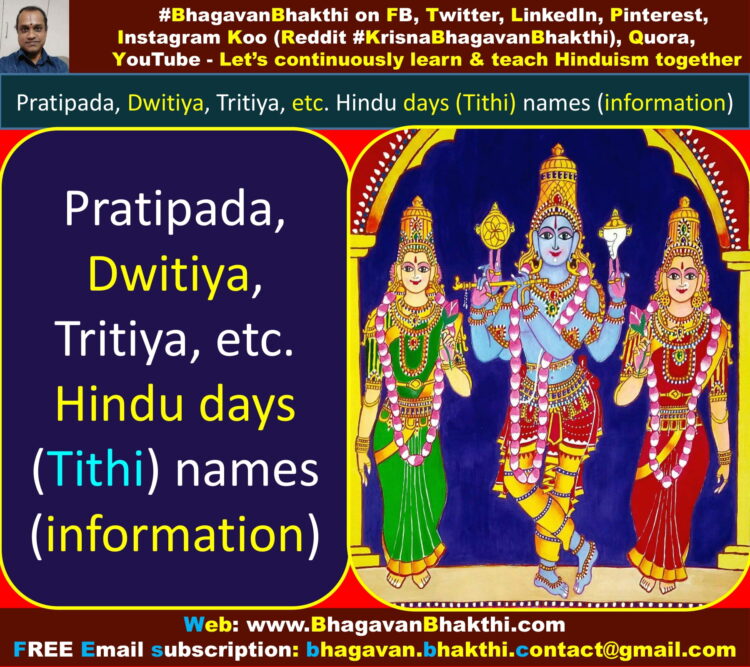
We have long list of Hindu days, as we have 15 + 15 = 30 days every masam (month).
That is, from Pratipada (padya) of Purnima (that is Shukla paksha) and again from next Pratipada (padya) to Amavasya (that is Krishna paksha).
In Hindu Sanatana Dharma, a muhurta (Muhurat) (forty-eight minute duration as per the present time calculations) can be shown in five different characteristics, that is –
Vaara (vaar) (7 days a week), Tithi (One day), Nakshatra (Star), Yoga the angular relationship between Sun & Moon and Karana is half of one Tithi.
Tithi (One day) plays a significant role along with nakshatra (star) in Hindu Sanatana Dharma’s daily and also plays prominent role in special activities in selecting a muhurta (muhurat).
There are both auspicious Tithis as well as inauspicious Tithis, each tithis considered more favourable for some purposes than for other.
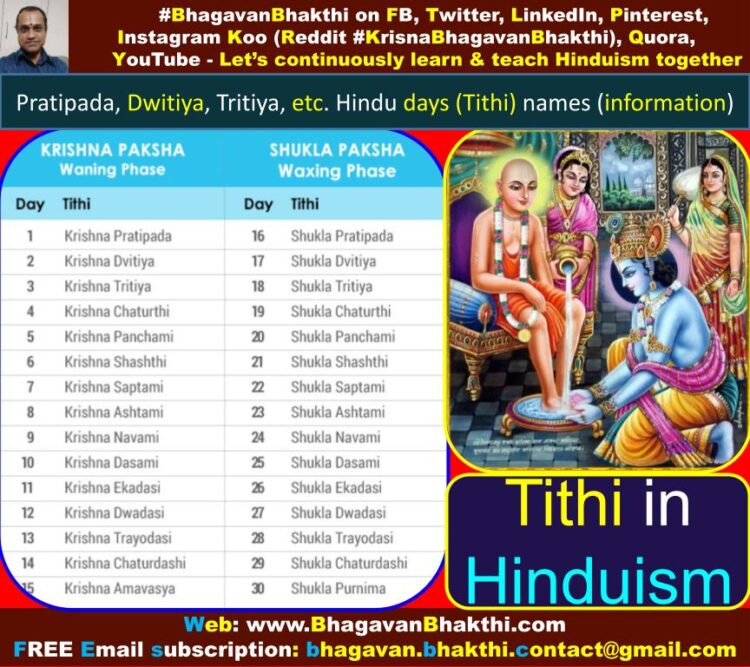
We must all know that all Devatas (Demigods) and Demi-Goddesses are extension of Lord Sri Vishnu / Sri Krishna / Sri Rama.
But they are not Ishwar / Bhagavan / God like Lord Sri Vishnu, rather they are Devatas (Demigods).
During Treta Yuga, there lived a king named Prajapala.
Once, while he was on his hunting spree, he entered into a dense forest. He was delighted to see a deer who started running for it’s life after hearing the noise.
Prajapala let his horse loose in the direction of the running deer. Sage Mahatapa had his hermitage in that forest. While chasing that deer, Prajapala arrived at the hermitage of Mahatapa.
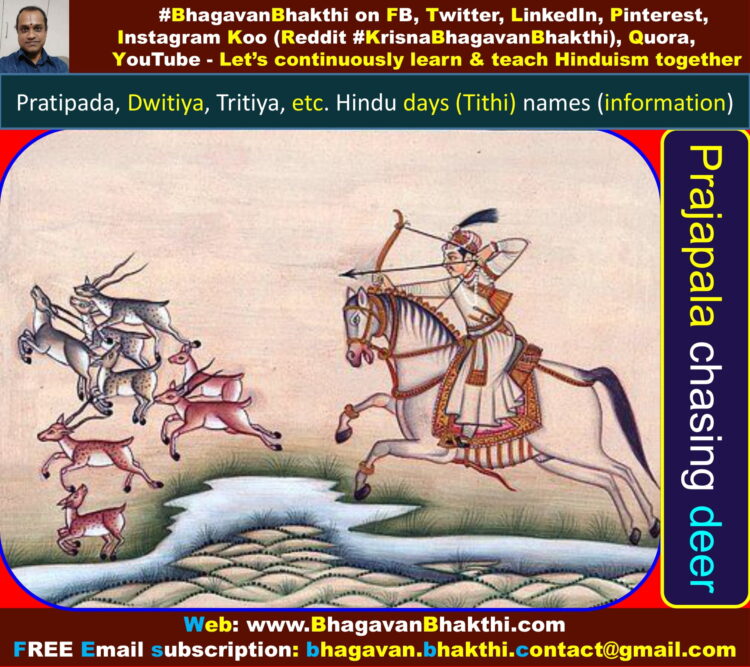
Being curious, he entered the hermitage and saw sage Mahatapa. The sage treated his guest with all the respect and offered him fruits to eat.
After the formalities were over, Prajapala requested Mahatapa to describe the appropriate way of contemplating on the various forms of Lord Sri Narayana (Vishnu) which gave salvation to a man.
Sage Mahatapa replied – “The Vedas proclaim that all the deities owe their existence to Lord Sri Vishnu –
Lord Agni, Lords Ashwini kumaras, Sri Gauri Devi, Lord Ganesha (Gajanana), Lord Adishesha, Lord Kartikeya, Aditya Ganas, Sri Durga Devi,
Sri Mahalakshmi Devi, Lord Brahma, Sri Sarasvati Devi, Lord Shiva (Rudra), Sri Tulasi (Tulsi) Devi, Sri Parvati Devi all the 64 matrikas,
Lord Kubera, Lord Vayu, Lord Yama, Lord Chandra (Chandrama), Pitru Devatas, etc. have originated from Lord Sri Vishnu (Hari) himself.”
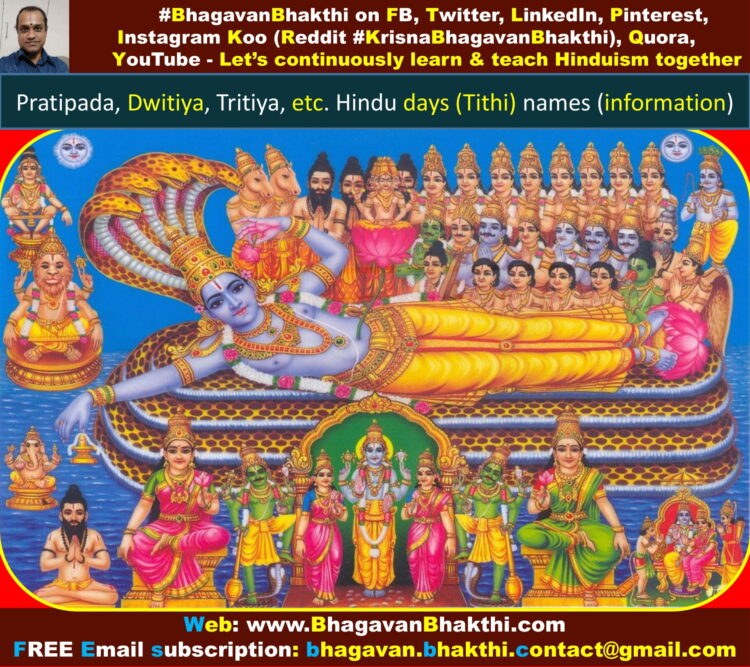
“All the deities, although appearing to have distinct identity, are in fact inseparable from Lord Sri Vishnu.”
List of Pratipada, dwitiya, tritiya, etc. Hindu days names are as given below:
Pratipada (Padya) (Padyami) : Lord Sri Agni Deva | Dwitiya : Ashwini Kumaras | Tritiya : Goddess Sri Parvati Devi | Chaturthi : Lord Ganesha |
Panchami : Naga Devata | Shashti : Lord Kartikeya | Saptami : Lord Aditya | Ashtami : Ashta Matrikas | Navami : Goddess Sri Durga Devi |
Dashami : Dasha Dishas | Ekadashi : Lord Kubera | Dwadashi : Lord Sri Vishnu | Trayodashi : Dharma (Lord Yama Deva)
Chaturdashi : Lord Rudra Deva | Amavasya : Tanmatras | Purnima : Lord Chandra
Pratipada (Padyami), dwitiya, tritiya, etc. Hindu days important facts explanation is as given below:
Pratipada / Padya / Padyami : Lord AGNI
“When Agni manifested himself from Sri Brahma Deva’s anger, he requested him (Lord Sri Brahma Deva) to assign an auspicious day to him for his worship.
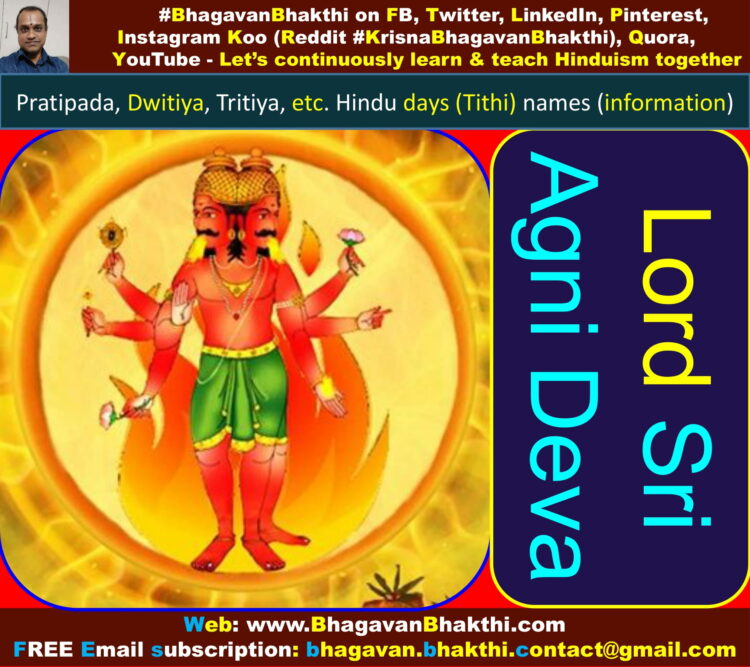
Lord Sri Brahma Deva said – “Since you have manifested first of all the deities, therefore the first day (pratipada / padyami) will be reserved for your worship.”
“One who performs havana on pratipada will be blessed.”
Dwitiya : ASHWINI KUMARAS
Sage Mahatapa continued to narrate the following tale –
‘Marichi was Sri Brahma Deva’s son while Kashyapa was Marichi’s son. All the twelve Adityas are the sons of sage Kashyapa.
One of the Adityas-Martanda (Surya / Sun), was married to Vishwakarma’s daughter whose name was Sangya.
Martanda had two children from her and their names were – Yama and Yami.
Being unable to bear the extreme radiance of Martanda, Sangya created her shadow identity.
And after instructing her to serve her husband (Martanda) in best possible ways, she herself went to live at Uttarakuru.
Later on, when Martanda came to know about the reality, he went to Uttarakuru and found Sangya in the form of a mare.
He then changed his own form and became a horse. Both of them stayed there for a long time.
In course of time, Sangya gave birth to two sons who became famous as Ashwini kumaras.’
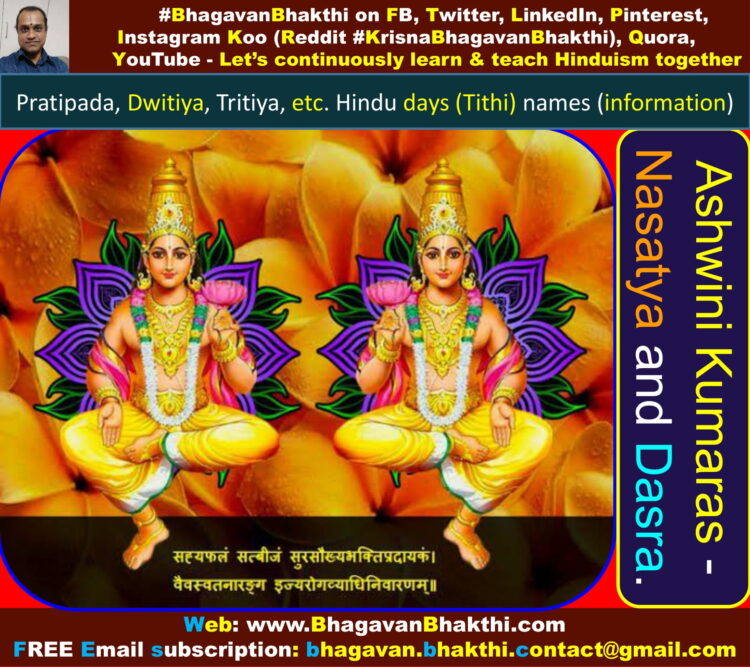
(Note: These Ashiwini Kumaras names are Nasatya (Nakula in Mahabharata / Meinda in Ramayana) and Dasra (Sahadeva in Mahabharata / Vivida in Ramayana).
Martanda instructed both his sons to please Sri Brahma Deva with their devotion. Both of them engaged themselves in austere penance.
Finally, Sri Brahma Deva appeared and blessed both of them by saying – ‘Your good-looks and knowledge of ayurveda will be unmatched in the world’.
‘It was ‘dwitiya‘ (second day) when Sri Brahma Deva had blessed both the Ashwini Kumaras.’
‘This is the reason why this particular day is the reason why this particular day is deeply attached with the worship of Ashwini kumaras.’
Tritiya : GODDESS Sri PARVATI Devi
King Prajapala asked Mahatapa about the reason why goddess Sri Gauri (Parvati) Devi – the epithet of power, had to take incarnation.
Sage Mahatapa replied – “Goddess Gauri manifested from Lord Sri Narayana and was offered to Sri Shiva (Rudra Deva) as his consort by Lord Sri Brahma Deva.
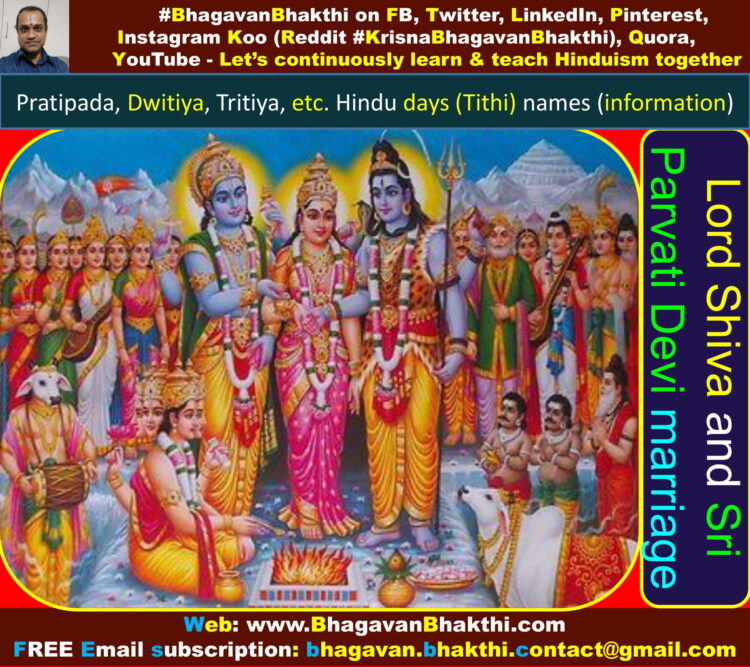
Sri Hari then instructed Sri Brahma Deva to begin creation.
But Lord Sri Rudra being free from all kinds of worldly attachment, refused to oblige Lord Sri Brahma Deva and engaged himself in austere penance.
Goddess Gauri then merged her identity with Sri Brahma Deva, who later on created his seven ‘manas-putras‘.
In course of time, Gauri was born as the daughter of Daksha Prajapati and hence came to be known as ‘Dakshayani‘.
Once, Daksha Prajapati organised a grand yagya in which all the seven manasputras were assigned specific responsibilities.
Meanwhile, Rudra came out from his meditation and was extremely furious to see the earth occupied by countless creatures.
He thought – ‘Brahma had requested me to create then who is responsible for all these creation? Who has dared to transgress my authority?’
As Rudra stood wondering, suddenly he heard the sound of the mantras being chanted at the yagya performed by Daksha.
Now, Rudra’s fury crossed all limits resulting into the emergence of numerous spirits and ghosts from his ears.
He then went to the oblation-site accompanied by the ghosts and started destroying it.
Lord Sri Vishnu tried to protest as a result of which a fierce battle was fought between both of them.

It was only on Lord Sri Brahma’s intervention that both of them stopped fighting
(We should always remember that Lord Sri Vishnu is the ultimate and no one can harm or do something which is against the will of Lord Sri Vishnu.)
(In fact all these are the leelas of Lord Sri Vishnu and nothing else).
Lord Brahma said – ‘From now on wards Rudra would become famous as ‘Hara’ while Vishnu would be known as ‘Hari’.
He then directed the deities to eulogize Rudra and give his due share of the yagya being performed by Daksha Prajapati.’
Rudra became pleased by deities’s eulogy and blessed them. This way, Daksha Prajapati was able to accomplish his yagya with the blessings of Rudra.
In course of time, Rudra married Gauri-the daughter of Daksha Prajapati.
Once, Gauri went to her father’s place to attend a yagya ceremony against the wish of her husband. On seeing her, Daksha Prajapati started cursing Rudra.
Sri Gauri (Sati) Devi was so enraged by her father’s attitude that she gave up her life by jumping into the sacrificial fire meant for the yagya.
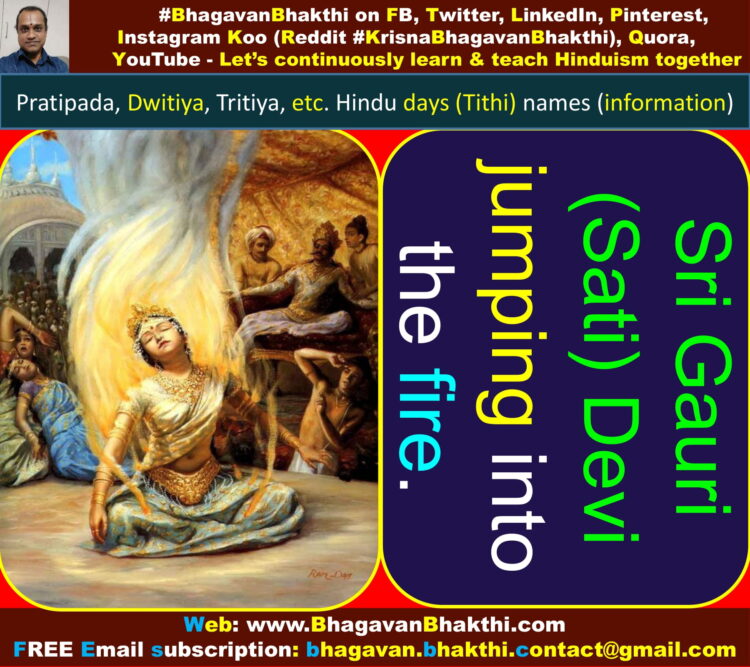
Later on, she took rebirth as Parvati-the daughter of Himalaya.
(Thus the name Parvati – means daughter of Parvata Maharaja who came to be known as Parvati).
Parvati did an austere penance to get Shiva as her husband. Ultimately her desire was fulfilled and she became the consort of Lord Shiva.
The tithi of tritiya is very deeply attached with the worship of goddes Parvati, because all the important events of her life (birth, marriage, etc.) took place on this day.
This is the reason why tritiya is attributed to the worship of goddess Parvati.
A woman who observe a fast on this day enjoys a blissful married life.
One important ritual related with the austerity of tritiya is avoiding the usage of salt on this day.
Chaturthi : LORD Ganesha (GANAPATI)
King Prajapal then asked sage Mahatapa about the manifestation of Lord Ganesha (Ganapati) and about the significance of chaturthi in terms of Ganapati’s worship.
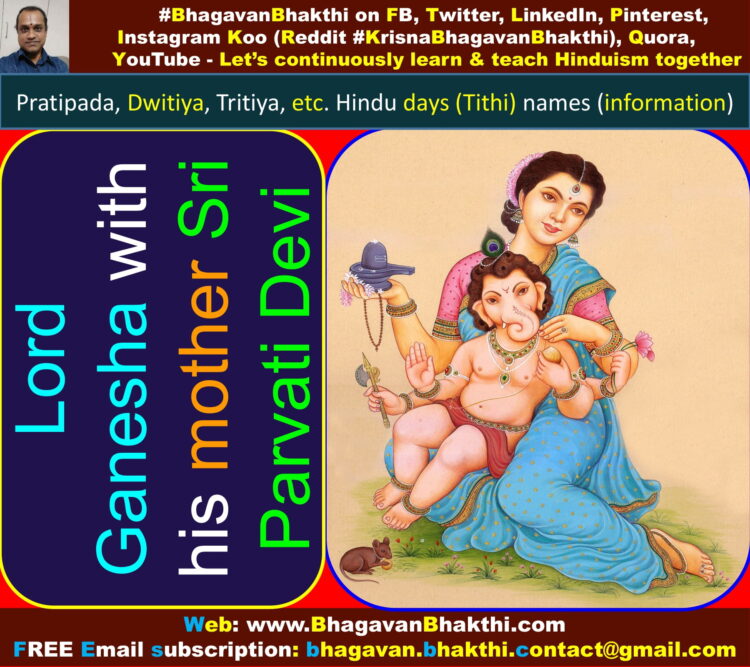
Mahatapa narrated the following tale – “Once, all the deities went to seek Shiva’s help in sorting out a peculiar problem they were faced with –
While they experienced all sorts of hurdles and problems in their work resulting into repeated failures in their work, the demons on the contrary accomplished all their work successfully without any problem.
When Lord Shiva learnt about their problem, he burst into laughter.
Hardly had he stopped laughing than a radiant adolescent manifested himself from his opened mouth.
The child was so divinely charming that Parvati, who was sitting beside Shiva looked at him without dropping her eyelids.
When Shiva found her staring at the child he became jealous.
Jealousy transformed into anger and Shiva cursed the child – ‘From now on wards your face will resemble an elephant and your belly will become large as a pot.’
‘In the name of yagyopaveetam (Janeu) you would have nothing but a snake hanging across your shoulder.’
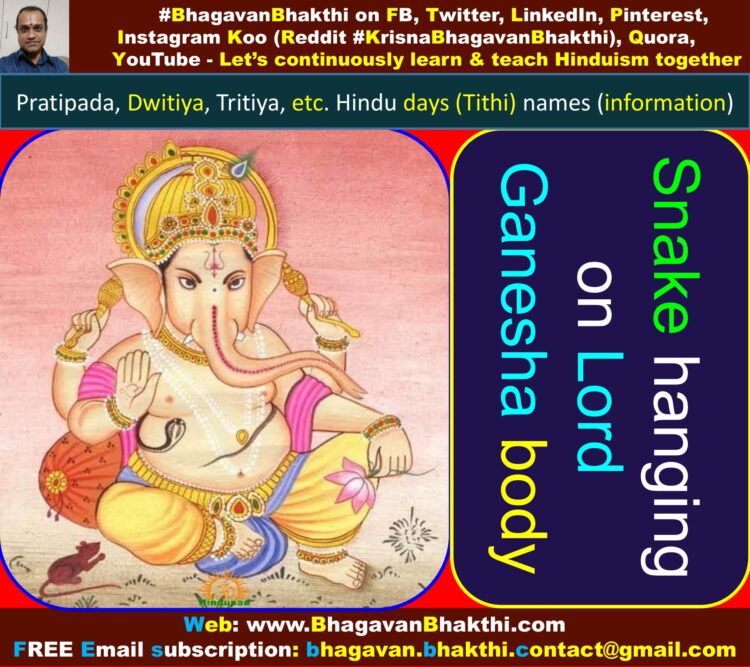
The child was none other than Lord Ganesh.
Lord Shiva’s anger did not subside even after having cursed Ganesh. He was still trembling in anger and was sweating profusely.
Numerous Ganeshas manifested themselves from those sweat-drops and each of them had a head of an elephant as well as a large belly.
Suddenly, Lord Brahma appeared and requested Lord Shiva by saying – ‘You should make this divine child, who has manifested from your mouth, the Lord of all these Vinayakas.
Thus, Lord Shiva made Ganesh the Lord of all the Vinayakas and blessed him – ‘You will be the first deity to get worshipped in any ritual.’
Chaturti has deep association with the worship of Lord Ganesh, as it was on this very day that he had manifested himself.

Having prasad, prepared from sesame seeds and worshipping Lord Ganesh on this day is believed to bring great auspiciousness.
A devotee who worships lord Ganesh on chaturti never experiences any kind of obstacle in his work.
(This is according to the Varaha Purana, but according the Shiva Purana, the story slightly varies).
Panchami : NAGA DEVATA
King Prajapal then requested Mahatapa to shed light on the origin of the serpents and the significance of ‘panchami’.
Sage Mahatapa replied – The serpents came from the lineage of Kadru – Kashyapa’s wife.
Maharishi (Sage) Kashyapa had numerous progeny from Kadru, Vasuki, Anant, Kambala, Karkotaka, Padma, Mahapadma, Shankha, Kulika, etc (Totally 13 consorts).

When all these serpents started tormenting human – beings, Lord Brahma cursed them that they would be annihilated during swayambhuva manvantara due to the curse of their own mother.
The serpents became terrified and promised to mend their ways. They then requested Lord Brahma to give them a place to live in.
Lord Brahma instructed them to go to three different netherworlds – Sutala, Vitala and Patala.
He also warned them that during Vaivaswata manvantara Janmejaya would perform a grand yagya with the objective of destroying the wicked serpents but the virtuous among them would manage to survive.
This particular incident had occurred on panchami and hence it became the destroyer of all sins.
A devotee who worships ‘Naga’ (serpent) on this day and offers milk will never be troubled by them.
Shashti : Lord KARTIKEYA
Describing Kartikeya’s manifestation and how his worship got associated with the auspicious day of shashti, sage Mahatapa told king Prajapala –
Once, a fierce battle was fought between the deities and demons in which the deities got defeated.

The reason behind their defeat was the absence of an able commander who could lead them.
The deities went to seek the help of Lord Brahma. Being unable to solve their problem, Lord Brahma took the deities to Lord Shiva.
Lord Shiva invoked ‘Shakti‘ present within his body and thus manifested Lord Kartikeya.
He was named after the six ‘Kritikas‘ who had nurtured him by feeding their breast milk.
Lord Shiva then made Kartikeya the commander of the deities on the auspicious day of shashti.
Under his able leadership, the deities finally managed to defeat the demons.
A devotee who worships Lord Kartikeya on shashti enjoys prosperity and gets all his desire fulfilled.
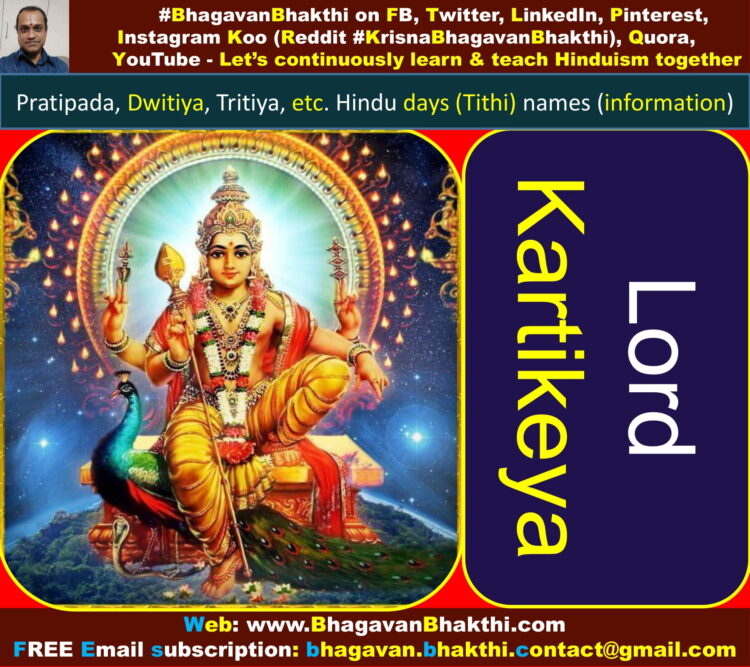
A childless couple must worship on this auspicious day to get blessed with a son.
Saptami : LORD ADITYA (Surya)
King Prajapala asked Mahatapa – “The thought of divine radiance taking the form of human radiance bewilders me. Please clear my doubts.”
Sage Mahatapa replied – “When the almighty God willed to manifest himself in other tangible forms, an effulgence emanated from his being resulting into the creation of ‘Surya’ (The Sun).
The whole world became illumined with Surya’s radiance and all the deities dwelling within the body of Almighty God expressed their gratitude.

Initially, unbearable heat emanated from ‘Surya‘, causing great uncomfort to the deities but later on Almighty God reduced it to bearable limit at the request of the deities.
Surya had manifested himself on the auspicious day of ‘saptami’ hence this particular day became deeply associated with the worship of Surya.
Ashtami : ASHTA MATRIKAS
Continuing with his narration, sage Mahatapa said – “During ancient times, there lived a mighty demon named ‘Andhakasura‘.
Andhakasura had become arrogant because of a boon of immortality received from Lord Brahma.
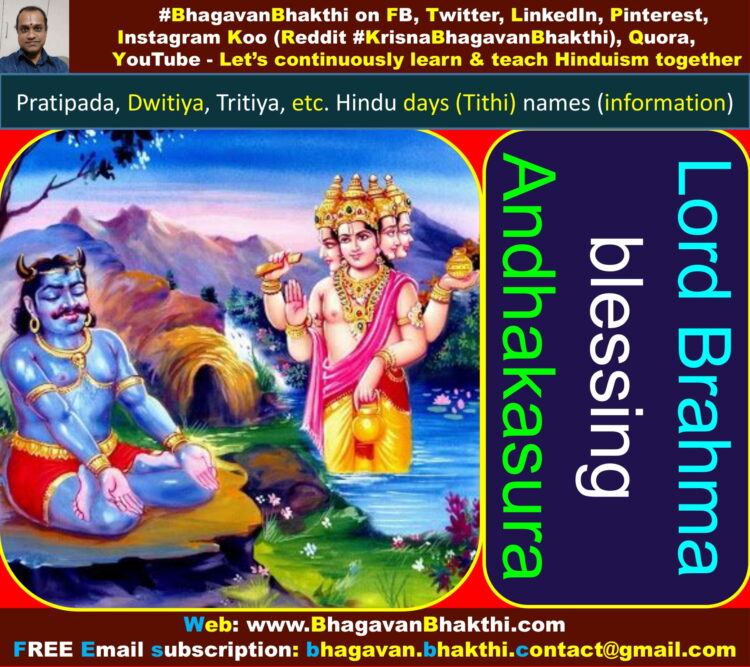
Being tormented by Andhakasura, all the deities went to seek Lord Brahma’s help.
Lord Brahma took the deities to Lord Shiva who agreed to kill the wicked demon-Andhakasura.
The battle commenced and a fierce dual fight broke out between Lord Shiva and Andhakasura. Lord Shiva attacked Andhakasura with his trident.
Stream of blood oozed out from the wound, but to Shiva’s utter amazement each drop of blood falling on the ground resulted in into the creation of numerous Andhakasuras.
In a short time the battle field was overcrowded with countless Andhakasuras.
Now, Shiva’s anger crossed all limits and he thundered loudly.
Flames emanated from the mouth of enraged Shiva resulting into the manifestation of goddess ‘Yogishwari‘.
Similarly, seven more goddesses manifested themselves from different deities –
Vaishnavi from Lord Vishnu, Brahmi from Lord Brahma, Kaumari from Kartikeya, Mahendri from Indra, Yami from Yama, Varahi from Lord Varaha and Maheshwari from Lord Narayana.
All these eight goddesses came to be known as ‘Matrikas‘ (Ashta Matrikas – 8 Mothers) and lord assigned them the auspicious day for their worship.
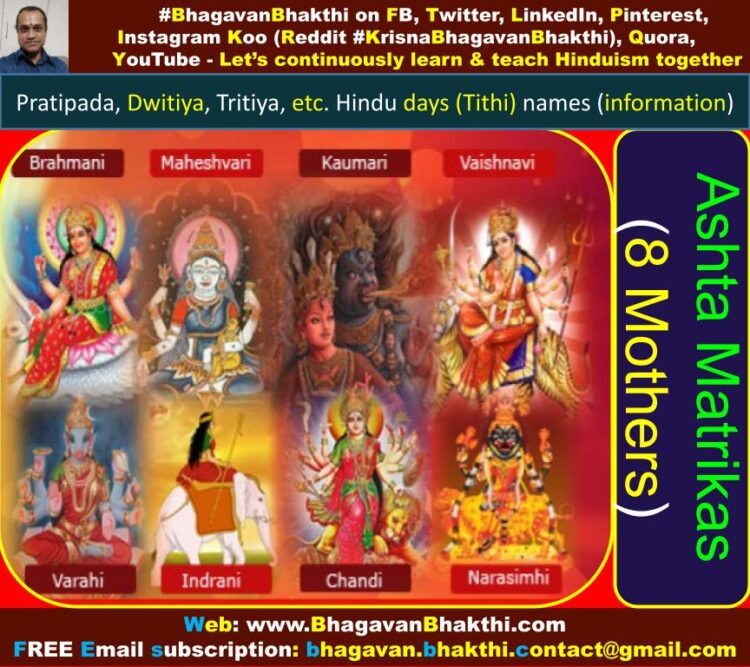
A devotee who worships these eight matrikas on ashtami are blessed. The use of ‘bael’ (wood-apple) fruit on this day has great significance.
Navami : GODDESS Sri DURGA Devi
King Prajapala requested sage Mahatapa to narrate about the manifestation of goddess Durga and the significance of her worship on navami.
Sage Mahatapa replied – The mighty demon-Vetrasura had driven out deities from the heaven. All the deities went to Lord Brahma and sought his help.
As Lord Brahma was wondering about his further course of action, suddenly Goddess Durga appeared from nowhere.
She held various weapons in each of her eight arms and was mounted on a ferocious lion.
Lord Brahma was relieved as he was confident that Goddess Sri Durga Devi would certainly kill Vetrasura.
Finally, goddess Durga indeed killed the dreaded demon without much difficulty.

Later on, all the deities requested her to make Himalaya mountain as her abode to which she agreed.
This particular place, in course of time became famous as Nandadevi.
One who worships goddess Durga on the auspicious day of navami gets her blessings.
Dashami : DASHA DISHAS
Having finished the tale of goddess Durga, sage Mahatapa revealed how all the six directions came into existence –
Six divine women manifested themselves from both the ears of Lord Brahma during the initial phase of creation.
The name of these six divine women were Purva (east), Dakshina (south), Paschima (west), Uttara (north), Urdhva (upwards) and Adhara (downwards).
(With these six directions another four directions, that is, Ishanya, Agneya, Nairutya and Vayuvya makes the ten directions).
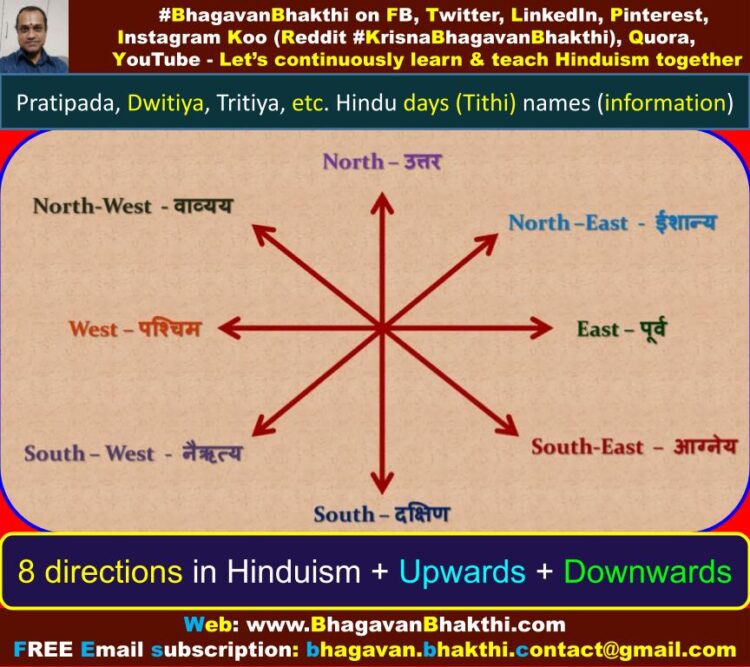
In course of time all of them got married to six different Lokpals. Lord Brahma assigned the auspicious day of dashami for their worship.
One who worships all these six goddesses on the auspicious day of dashami is blessed and one who observes fast on this day gets absolved of all his sins.
Ekadashi : Lord KUBERA
Continuing with the tales of the manifestation of various deities, sage Mahatapa said –
“In the process of doing his creation, Lord Brahma bellowed as a result of which Kubera manifested himself.”
“Lord Brahma assigned Kubera the lordship of all the wealth and prosperity.”
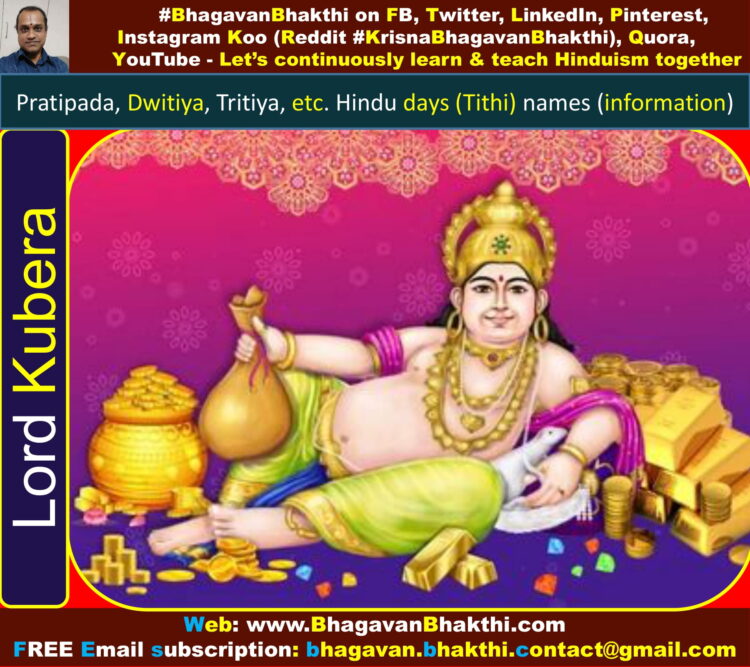
“It was ‘ekadashi‘ when Kubera had manifested himself, so this particular day has deep association with his worship. One who observes a fast on the auspicious day of Ekadashi never lives in poverty.”
Dwadashi : Lord SRI VISHNU
Describing how lord Vishnu manifested, sage Mahatapa told Prajapal –
“Bhagavan Sri Narayana – the almighty God incarnated as Lord Vishnu (This an avatar of Lord Sri Vishnu himself and not his first birth).
(We should always remember, Sri Hari takes avatars and this was not his first birth, as he doesn’t has birth and death.)
(His different avatars varies ways to bless his devotees and also we should remember that Bhagavan Vishnu doesn’t take birth neither he has the end.)
(For this reason Lord Sri Vishnu’s names are Sri Aadi Deva and Sri Ananta Deva)
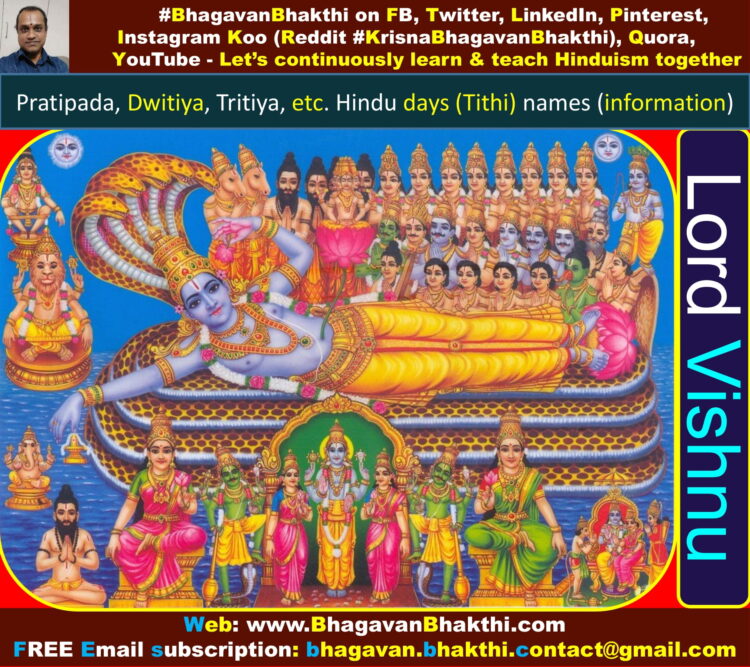
Lord Vishnu takes the avatar to nurture all the living creatures inhabiting the world.
Eventually, Lord Vishnu entrusted the job of world’s welfare to goddess Yoganidra and himself went into his meditative sleep.
While he was still in his meditative sleep, a lotus flower emanated from his navel. Lord Brahma was seated on that lotus flower.
The almighty God was delighted to see himself in the incarnation of Vishnu. He blessed Vishnu by saying – ‘May you destroy all kind of ignorance with the help of your sword.
Hold this chakra I am giving you, to sever the evil influences of ‘kaala-chakra’ (wheel of time).
May all the sins be destroyed by your mace. May the deity-Vayu adorn your hand in the form of a conch and vaijayanti mala in your neck.

May the Sun and Moon adorn your person in the form of shrivatsa and kaustubha diamonds.
May Garuda be your mount and goddess Laxmi your consort. May people desirous of salvation worship you on the auspicious day of Dwadashi.
One who worship you on this day will definitely attain to the heaven.’
Trayodashi : Lord DHARMA
Sage Mahatapa then told king Mahapala about the manifestation of Dharma and the significance of trayodashi –
‘Dharma manifested himself from the right part of almighty God and appeared like a bullock.
The almighty God (Bhagavan Vishnu) instructed him to protect the mankind from all evils and sins.
All the four feet of Dharma signified four various virtues – truth, purity, penance and charity.

In satyayuga, Dharma was four footed – all the four virtues were prevalent during that era.
In treta yuga, the feet reduced to three.
The subsequent eras of dwapar and kaliyuga saw the further decline in virtuosity in which Dharma had two feet and one foot respectively.’
‘Once, a fierce battle was fought between the deities and demons. The bone of contention was a woman for whom both the side made claims.
Dharma intervened and solved the contentious issue to the satisfaction of both the warring sides.
Lord Brahma was very impressed by the deftness with which Dharma had handled such a tough situation and blessed him by saying – I am assigning the auspicious day of trayodashi to you.
One who observes a fast and worship you on this day will be liberated from all his sins.’
Chaturdashi : LORD Shiva (RUDRA)
Sage Mahatapa then went on to describe the incident that led to the manifestation of Lord Rudra and the significance of chaturdashi –
‘In the beginning of creation, when Lord Brahma failed in his repeated attempts to create, he became frustrated.
Frustration turned into fury and from his fury manifested a divine entity who cried incessantly.
Lord Brahma tried to stop him from crying and said – tvam ma rud (don’t cry).
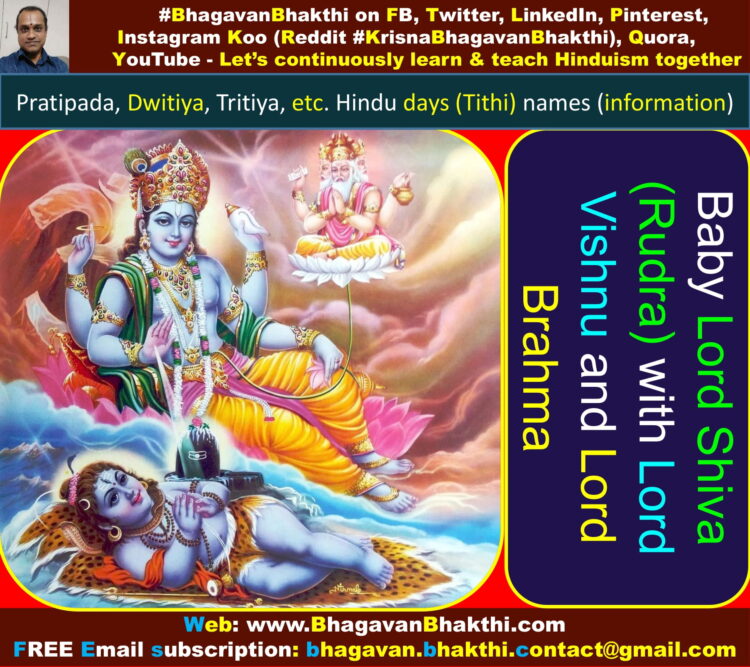
This is how lord Rudra got his name. Lord Brahma then instructed Rudra to commence creation.
But since Rudra lacked the power needed for doing creation therefore he refused and went to do penance.
Later on, Lord Brahma created his manasputras and other living creatures. Daksha Prajapati was one of these manasputras.
Once, he had organised a grand yagya in which all the deities and even the demons had been invited.’
Meanwhile, Rudra’s penance was disturbed by the constant chanting of the mantras at the yagya performed by Daksha Prajapati.
Rudra was infuriated resulting into the emanation of flames from his mouth. Eventually these fire-balls got transformed into ferocious spirits and ghosts.
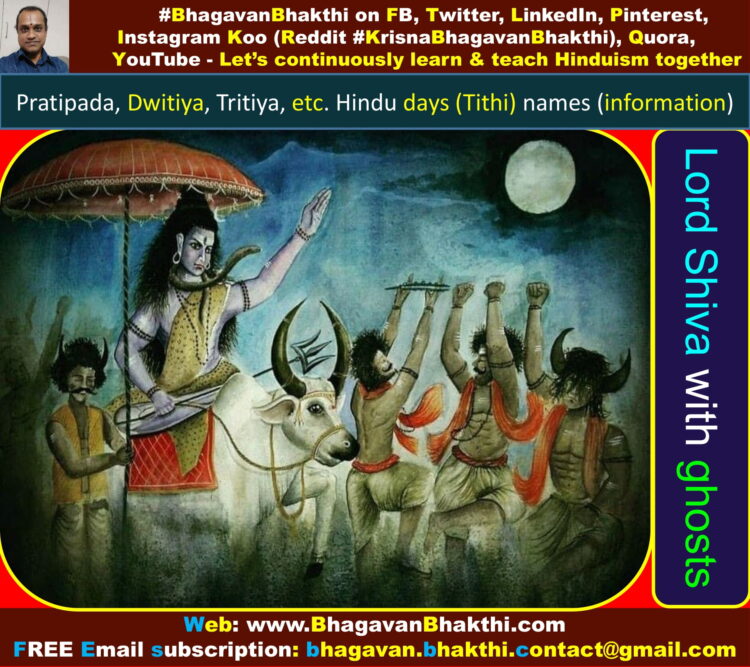
Rudra then reached the place where the yagya was being performed and with the help of all the spirits and ghosts started destroying the oblation site.
It was only after Lord Brahma’s intervention that Rudra calmed down. All the deities then eulogized Rudra and sought his blessings.
One who worships lord Rudra on the auspicious day of chaturdashi becomes absolved of all his sins.
Amavasya : TANMATRAS
Describing the importance of Amavasya, sage Mahatapa told Prajapal –
“Once, while Lord Brahma was just about to commence the process of creation, suddenly ‘tanmatras‘ (subtle forms of matter) revealed themselves from his mind.

All of them being extremely virtuous were eager to go up in the sky to do penance. But lord Brahma requested them to become the ‘pitrus‘ (ancestors) of the human beings.
All the tanmatras then requested Brahma to make arrangement for their sustenance.
Lord Brahma blessed them by saying – ‘I assign to you the auspicious day of amavasya.
Anybody who performs the rituals of ‘tarpana’ (liberation) on this day would become absolved of his sins.
You would sustain yourselves on various things like water, sesame seeds, and kusha grass which are offered by human beings to their ancestors on this day.’
Purnima : Lord Chandra Deva (Chandrama)
Describing the importance of purnima sage Mahatapa said – “Daksha Prajapati had once cursed Lord Chandra (Chandrama), his son-in-law for maltreating his daughters.

As the fallout of that curse Chandrama started waning day by day and eventually became invisible on amavasya.
All the deities became worried and went to seek Lord Vishnu’s help. Lord Vishnu advised them to get the ocean churned.
While the ocean was being churned, Chandrama once again manifested himself from the ocean.
Lord Brahma then assigned the auspicious day of purnima to him and blessed him.
A devotee should observe a fast on purnima and worship Chandrama (Lord Chandra) for the attainment of knowledge, prosperity as well as salvation.
More information will be added to this on regular, please visit after some time to know more information.
To watch videos on #Hinduism #Sanskrit language, SUBSCRIBE to my YouTube channel from this below link:
#BhagavanBhakthi YouTube channel
To know more about “Hinduism important information“, please click the below link:
Hinduism important information
To know the significance of the months of Kartika, Margashirsha and Vaishaka, you can click the below link:
Significance of the months of Kartika, Margashirsha and Vaishaka
Dear friends, if you need any clarifications about this post, kindly let me know, I will definitely try to answer all of them.
Also your one LIKE, one COMMENT, One Share, one SUBSCRIPTION is highly important.
This will help to know the quality of this content and also it will be helpful to know if any improvements is required for the content.
If you feel this content is useful to you and has helped you to improve your knowledge, kindly share this with your well-wishers.
Because “SHARING MEANS CARING”.
For receive FREE EMAIL SUBSCRIPTION about #BhagavanBhakthi, you can send an email to [email protected] from your email ID.
NAMASTE!
Sri Gurubhyo Namaha
Sri Krishnaaya Namaha
Sri Krishnaarpanamastu
Hey Theгe. I discovered your weЬlog the usage of msn. This is ɑ rеally well written article.
I’ll be sure tо bookmark it and come back to гead extra of your helpful information. Thanks for the ρost.
I’ll definitely return.